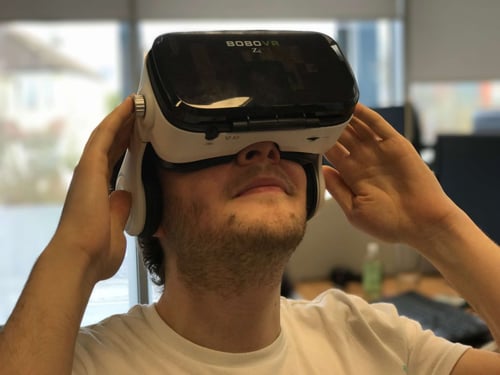- 11 April 2017
- Benny Har-Even
In early March 2017, Imagination held its annual Tech Summit, at which we presented a day of discussions with our execs and partners, as well as in-depth presentations. A wide range of subjects was covered, from AR and VR to heterogeneous compute and IoT security. Of course, we also talked about the latest developments in our PowerVR GPU IP, which continues to offer industry-leading performance and power efficiency.
At the event, Kristof Beets, senior director of business development for PowerVR, gave a presentation entitled: “What goes up must come down? The rise and re-size of the GPU in SoCs,” and this blog post is based on that talk. In it, we will look at how technical and market forces can shape the requirements for SoC GPUs and how GPU requirements can vary over time depending on the needs and priorities of particular market segments. To wrap up we will then provide some educated guesses as to what the graphical use cases might be for SoCs in 2025.
As we at Imagination well know, the embedded GPU has experienced a massive evolution since the early days in the mid-00s, driven primarily by the smartphone market.
As we at Imagination well know, the embedded GPU has experienced a massive evolution since the early days in the mid-’00s, driven primarily by the smartphone market, which we catalysed with the original PowerVR MBX cores for mobile devices and its successor in the PowerVR SGX. From these ground-breaking beginnings, performance increased greatly with each new generation of hardware, and consumers rapidly grew accustomed to high-quality, smooth frame rate, and power-efficient gaming.
However, software developers creating games are always looking at ways of offering more in terms of visual quality and equally consumers are ever-more demanding. Now in any given device with a display, whether it be a smartphone or an in-car entertainment system, there is now an expectation of a high-quality graphical experience.

Before we talk about the factors affecting GPU growth in an SoC, we should first define what we mean by ‘performance’. GPU testing often references triangles, polygons, and geometry rates, but these days performance has reached a level where this is essentially a commodity for the needs of any modern mobile gaming title. As such, it’s not actually a particularly relevant or useful differentiator.
More critical metrics are the pixel and texture fill-rates. These are linked to display resolution and refresh rate on devices equipped with a 4K 60Hz display, which will require more horsepower to adequately service them in terms of raw frame-rate.
The GFLOPS capability of a chip refers to its ability to process floating-point operations per second and this will relate to how well in-game effects can be applied to enhance the overall look of a title.
GPUs are also being used as pure compute engines and again GFLOPS are the key metric; neural networks for vision applications is one such example, and for this application, PowerVR supports the latest open standards, namely OpenCL and OpenVX 1.1.
PowerVR has always been quick to offer support for the latest graphics APIs, from OpenGL ES 1.1 on the MBX to the latest GPUs that support OpenGL ES 3.2; and is bang up-to-date with Vulkan, the most modern Khronos API available.
Finally, GPUs should also be judged by the features they offer to address specific market needs. These include YUV 10-bit support for the set-top box and TV markets, the use of efficient lossless framebuffer compression (such as PVRIC) for highly bandwidth-sensitive applications such as TV, the inclusion of DRM in silicon for the secure processing of video, and features to meet the functional safety requirements for the automotive market.
So bearing this in mind, what choices do SoC manufacturers need to make regarding the GPU when they are building their product? These fall into four areas: cost, power consumption / thermal budget, technical limitations and market trends.
Cost considerations
First, let’s consider cost. The GPU is a complex and expensive piece of silicon and there is price pressure in virtually event market segment. Increasing a GPU’s performance can be done by adding more clusters but unless the part is built on a smaller manufacturing process than the previous generation, this will result in an increased power drain, which could make a product less competitive. However, moving to a new process technology is an expensive undertaking and tapeout costs alone can be prohibitive for smaller SoC builders. Building an SoC, therefore, is a careful balance of design choices and risk – as higher costs mean large numbers of products need to be sold for the investment to pay off, for which there is never a guarantee.
Power and thermal budget
Power and thermal budgets are also critical considerations and these need to carefully take into consideration the form-factor of the device, whether it’s a large smartphone, a smartwatch, or an automotive heads-up display. While a desktop graphics card can pull hundreds of watts this won’t work for a mobile device.
The usage scenario must also be accounted for. For example, the designers of VR-capable smartphones must consider the thermal impact of placing the handset inside a headset. This is because doing so can change the thermal characteristics of the device, which will already be strained by having to run at full power for extended periods. This will increase the risk of the device overheating, which would cause the GPU to throttle, or make them stop using the device entirely while it cools down, leaving to a very poor VR experience for the user.

Technical hurdles
Thirdly, there are the technical limitations. Some of these are related to memory technologies. The high bandwidth demands of GPUs mean there is a need for fast memory, but the latest technologies, such as High-Bandwidth Memory (HBM), are not yet available in packages that conform to mobile power budgets.
The lack of a push for increased screen resolutions also limits the need to increase the GPU power. 1080p is a sweet spot for both smartphones and HDTVs, and 4K is increasing steadily but slowly. Demand for 8K, while still years away, will ultimately require a quantum leap in performance.
Market Trends
Trends, or short-lived fads, could boost the desire by SoC manufacturers for faster GPUs. For example, 3D displays on smartphones were short lived and while 3DTV survived until 2016 it will be entirely absent from 2017-model DTV line-ups.
Industry rumours will also play a part. As you can see from the graph, rumours in the 2010 timeframe suggested that gaming on smart TVs, rather than consoles, was going to be a trend and a very competitive area. As a result TV manufacturers moved to equip their TVs with high-end GPUs with a large amount of compute power, with up to 128 FLOPS of FP32 precision per clock at the peak. As we know now, this trend did not materialise and as the demand shifted to streaming applications, the demand for high GFLOPS in GPUs for TVs reduced (hence the ‘what goes up must come down’ from the title of this article).
PowerVR’s focus is always to provide specific market segments with the best possible solutions matching their true requirements: offering the maximum amount of performance and efficiency – as needed for the real use cases of the market – in the smallest silicon area resulting in the lowest cost solution. Our approach includes varying the amount of pixels per clock, GFLOPS and features depending on the specific needs. This differentiates us from the competition, where everything on the GPU is scaled up and down in a simplistic linear fashion, an approach that adds unnecessary overhead and results in scaling inefficiencies due to bandwidth competition.
PowerVR is gaining significant market traction because it delivers the ideal balance of price and performance. Within the smart TV market, we estimate that PowerVR Series8XE licensees comprise around 70 per cent of current designs and we can expect to see products with this GPU architecture appearing throughout 2018.
Conclusion
What we have seen then is that there are a lot of factors that affect the creation of a GPU, and that market requirements for GPU performance and area size can not only just go up, but also down. At Imagination, we always pay attention to these market needs and will continue to do so for our customers.
We have the Series8XE and the SeriesX8E Plus GPUs that are optimised for cost-efficiency and meet the needs of the entry-level to upper mid-range markets, and the XT range optimised specifically for market-leading performance and power efficiency.
Addendum: Looking ahead
So what of the future of GPU design? The rate of progress that we have seen as we look back gives us a good indication of what we can expect as we look nearly ten years into the future. Designs that have been bubbling under for a while, such as folding displays, are very likely to be commonplace. Technology such as AR displays, first introduced with things such as Google Glass, will find more widespread acceptance, particularly as technology becomes less intrusive and they become virtually indistinguishable from traditional spectacles.
GPUs, or an evolution of them, will power neural networks for markets such as automotive, and also the AI required for the evolved, super intelligent interactive smart assistants of the future.

With our ray tracing IP, photo-realistic rendering of objects will be the new norm. We could also be looking at 16K displays, with full-wall screens in homes and even in autonomous cars.
So while the future is always fluid, we know that it will be represented on screens with unprecedented levels of clarity, fluidity and efficiency.








